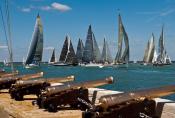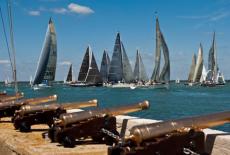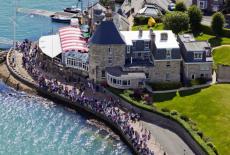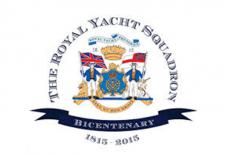Royal Yacht Squadron Bicentenary - Cowes

01.06.2015

Royal Yacht Squadron - Cowes
1st June 2015 is the Bicentenary of the Royal Yacht Squadron, Cowes UK.
This is two hundred years to the day since the inaugural meeting at the Thatched Tavern.
Founded in 1815, the Royal Yacht Squadron is the most prestigious yacht club in the United Kingdom and arguably the world.
The Royal Yacht Squadron clubhouse is located in Cowes Castle on the Isle of Wight. Queen Elizabeth II is patron and the club’s Admiral is Prince Philip.
Founded on 1 June 1815 in the Thatched House Tavern in St James’s, London as The Yacht Club by 42 gentlemen interested in sea yachting. The original members decided to meet in London and in Cowes twice a year, to discuss yachting over dinner. Membership was restricted to those who owned a vessel not under 10 tons. Today this is interpreted as any gentleman or lady, “actively interested in yachting”.
The Earl of Yarborough, later first Commodore of the Yacht Club, welcomed the Prince Regent as a member in 1817. In 1820, when the Prince Regent became George IV, it was renamed the Royal Yacht Club. The Club started organising racing as a principal feature of the annual regatta, which is now known as Cowes Week. In 1833 William IV renamed the club, The Royal Yacht Squadron.
Its association with the Royal Navy began early and Nelson’s Captain at Trafalgar, Admiral Sir Thomas Hardy, headed the list of Naval members. The spirit of invention led to yachts “of such celerity in sailing and beauty of construction” that they were of utility to the Royal Navy.
Early yachts were similar to (or had been) Royal Navy cutters, smuggling and pilot vessels. Keen competition between racing members led to rapid improvements in yacht design, then to the development of handicapping and rules for racing.
The Royal Yacht Squadron & Yachting History >
Royal Yacht Squadron - Home >
Image 1: Swan European Regatta - credit Kurt Arrigo & Nautor Swan press
Image 2: Cannons at Cowes - credit RYS / Image 3: Royal Yacht Squadron - credit Rolex
The Squadron was the arbiter of the sport for most of the 19th century, before the advent of the various national and international bodies, and both the club itself and individual members have continued to be at the forefront of yachting developments and eminent in the sport.
There is also a strong tradition of cruising far afield – one founder member missed the inaugural meeting as he was cruising to St Petersburg, another is believed to have returned from a cruise which included a visit to Napoleon on Elba.
Members have published accounts of voyages made for exploration, for natural history research or just for pleasure. Lord Brassey’s Sunbeam logged 37,000 miles and another wide-ranging member, Ben Boyd, was captured and eaten by natives of the Solomon Islands in 1851. More recent members have included famous Round the World yachtsmen Sir Francis Chichester, Sir Alec Rose and Sir Robin Knox-Johnston.
The Squadron has always had a close association with the Royal Navy and in 1829 the Admiralty issued a warrant to wear what is now the navy’s White Ensign. The burgee (a triangular shaped flag identifying yacht club membership) is differenced with a St George’s Cross and crown on a white background.
The first Commodore, Lord Yarborough, assured the King in 1833 that ‘it will ever be our most earnest wish and desire to promote, in every way in our power, naval science and architecture’. Early members, such as Lord Belfast with his famous brig Waterwitch, built experimental vessels which did much to advance naval ship design.
Members’ yachts went to the Crimea and took part in both World Wars. In the Second World War the Squadron offered its clubhouse to the Admiralty and the castle became HMS Vectis, suffering damage in the air raids on Cowes which was targeted because of its important shipbuilding industry.
The club’s present home, Cowes Castle, was built in 1539 as part of Henry VIII’s chain of coastal defences, protecting the Island from invasion and the naval dockyard at Portsmouth from attack. Its defensive importance lessened after the defeat of Napoleon in 1815 and it was later suitably refurbished to become the maritime residence of the Captain of Cowes Castle, Lord Anglesey, who was also a member of the club.
The death of the last Captain in 1855 led to a review of the castle’s future and its decommissioning. The Squadron leased it a couple of years later and employed the architect Anthony Salvin to turn it into a fitting home from home for the members; they moved in, from their previous clubhouse on Cowes Parade, in 1858.
Source: Royal Yacht Squadron - 2015
All images are copyright RIB & HSC 2024 unless otherwise stated.
This does not exclude the owner's assertion of copyright over the material.
05.04.2024
Hydro Motion - H2 from NL to England in 2024
The TU Delft Hydro Motion Team wants to cross to…
05.01.2024
The Challenges of Unpredictable Marine Energy
From military to superyacht, it is clear there is an urgent…
Speed@Seawork 2024
Dates:
10th June 2024
Location:
Cowes, Isle Of Wight,
Foiling and Flying RIBs
Foiling powerboat designed to meet military needs - fast, stable, silent, fuel-saving. Collaboration by SEAir Foiling Systems and Sillinger RIBs.…

















